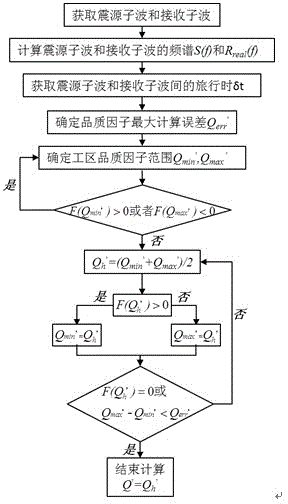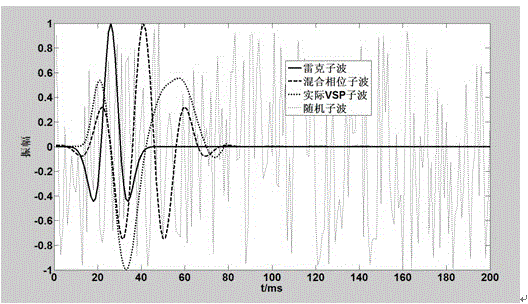Method for estimating equivalent quality factor and method for estimating stratum quality factor by using method for estimating equivalent quality factor
A quality factor, equivalent technology, applied in the field of exploration geophysics, which can solve problems such as limiting the accuracy of the applicability of the centroid frequency shift method
- Summary
- Abstract
- Description
- Claims
- Application Information
AI Technical Summary
Problems solved by technology
Method used
Image
Examples
Embodiment 1
[0082] Example 1. A method for estimating an equivalent quality factor, the method may further comprise the steps:
[0083] 1. Extraction of source wavelet and receiver wavelet, calculation of their amplitude spectrum and travel time between them
[0084] Step 1: Source wavelet and receiver wavelet extraction
[0085] For zero-bias VSP data, the direct wave received by the near-surface geophone can be used as the source wavelet, and the direct wave received by the far-surface geophone can be used as the receiving wavelet; in actual operation, 1.5 cycles of seismic waves can be intercepted from the take-off point wavelength as the direct arrival wave.
[0086] Step 2: Calculation of amplitude spectrum of source wavelet and receiver wavelet
[0087] The extracted source wavelet and receiver wavelet are respectively applied to the Fourier transform method to calculate the corresponding amplitude spectrum.
[0088] Step 3: Determine the travel time between source wavelet and r...
Embodiment 2
[0126] Example 2. The method for calculating the formation quality factor includes the following steps:
[0127] Step 1: Divide the medium into several thin layers with the distance between two adjacent geophones in the well as the thickness;
[0128] Step 2: Calculate the equivalent quality factor between the source point and each receiver point by using the method for estimating the medium equivalent quality factor described in any one of claims 1 to 5;
[0129] Step 3: Calculate the quality factor of each thin layer
[0130] Since the above-mentioned equivalent quality factor represents the average value of the total absorption effect corresponding to the total time of the formation that propagates from the source point to the depth of each receiver point, rather than the layer quality factor corresponding to adjacent receiver points, the relationship between the two is as follows ,
[0131] ( Σ k ...
Embodiment 3
[0137] Example 3. The method for calculating the formation quality factor includes the following steps:
[0138] Step 1: Set up geophones at the boundary points of each formation in the well;
[0139] Step 2: Calculate the equivalent quality factor between the source point and each receiver point by using the method for estimating the medium equivalent quality factor described in any one of claims 1 to 5;
[0140] Step 3: Calculate the quality factor of each layer
[0141] Since the above-mentioned equivalent quality factor represents the average value of the total absorption effect corresponding to the total time of the formation that propagates from the source point to the depth of each receiver point, rather than the layer quality factor corresponding to adjacent receiver points, the relationship between the two is as follows ,
[0142] ( Σ k = 1 i...
PUM
 Login to View More
Login to View More Abstract
Description
Claims
Application Information
 Login to View More
Login to View More - R&D
- Intellectual Property
- Life Sciences
- Materials
- Tech Scout
- Unparalleled Data Quality
- Higher Quality Content
- 60% Fewer Hallucinations
Browse by: Latest US Patents, China's latest patents, Technical Efficacy Thesaurus, Application Domain, Technology Topic, Popular Technical Reports.
© 2025 PatSnap. All rights reserved.Legal|Privacy policy|Modern Slavery Act Transparency Statement|Sitemap|About US| Contact US: help@patsnap.com



